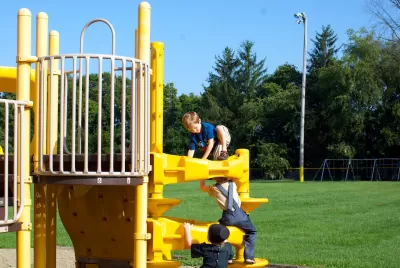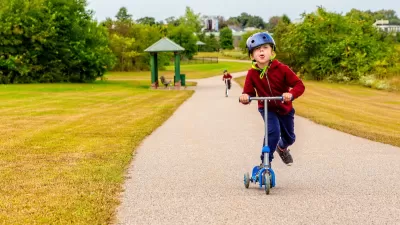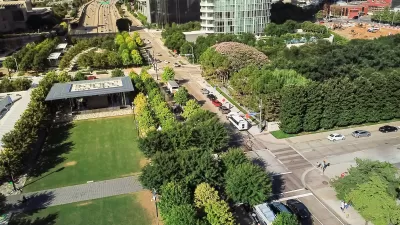Opening schoolyards to the public could be 'game-changing' for communities lacking in green space.

The Trust for Public Land's Community Schoolyards report highlights the potential for the country's public schoolyards to serve as public parks. The Trust "believes that transforming America’s schoolyards into shared public parks by 2030 is a common-sense, cost-effective solution to America’s park equity problem. Opening all public schoolyards during non-school hours would put a park within a 10-minute walk of nearly 20 million people—solving the problem of outdoor access for one-fifth of the nation’s 100 million people who don’t currently have a park close to home."
The report also outlines steps schools can take to make their schoolyards more inviting, healthy, and safe. These suggestions include "[s]wapping out blacktop for trees, gardens, and up-to-date play equipment," which "would deliver a raft of benefits to students, from emotional to academic."
According to analysis conducted by the Trust, "[i]n the 100 largest U.S. cities, neighborhoods where residents predominantly identify as people of color have access to an average of 44 percent less park acreage than predominantly white neighborhoods." Community Schoolyards seeks to reimagine the drab asphalt schoolyard as an inspiring, healthful environment for both students and the community at large. "Renovated schoolyards can also serve as vital green space for the entire community. Growing numbers of districts are allowing local residents to use their school grounds after school and on weekends, giving not only students but people of all ages new access to parkland."
FULL STORY: A game-changing solution to America’s park equity problem

Alabama: Trump Terminates Settlements for Black Communities Harmed By Raw Sewage
Trump deemed the landmark civil rights agreement “illegal DEI and environmental justice policy.”

Planetizen Federal Action Tracker
A weekly monitor of how Trump’s orders and actions are impacting planners and planning in America.

The 120 Year Old Tiny Home Villages That Sheltered San Francisco’s Earthquake Refugees
More than a century ago, San Francisco mobilized to house thousands of residents displaced by the 1906 earthquake. Could their strategy offer a model for the present?

In Both Crashes and Crime, Public Transportation is Far Safer than Driving
Contrary to popular assumptions, public transportation has far lower crash and crime rates than automobile travel. For safer communities, improve and encourage transit travel.

Report: Zoning Reforms Should Complement Nashville’s Ambitious Transit Plan
Without reform, restrictive zoning codes will limit the impact of the city’s planned transit expansion and could exclude some of the residents who depend on transit the most.

Judge Orders Release of Frozen IRA, IIJA Funding
The decision is a victory for environmental groups who charged that freezing funds for critical infrastructure and disaster response programs caused “real and irreparable harm” to communities.
Urban Design for Planners 1: Software Tools
This six-course series explores essential urban design concepts using open source software and equips planners with the tools they need to participate fully in the urban design process.
Planning for Universal Design
Learn the tools for implementing Universal Design in planning regulations.
Clanton & Associates, Inc.
Jessamine County Fiscal Court
Institute for Housing and Urban Development Studies (IHS)
City of Grandview
Harvard GSD Executive Education
Toledo-Lucas County Plan Commissions
Salt Lake City
NYU Wagner Graduate School of Public Service





























